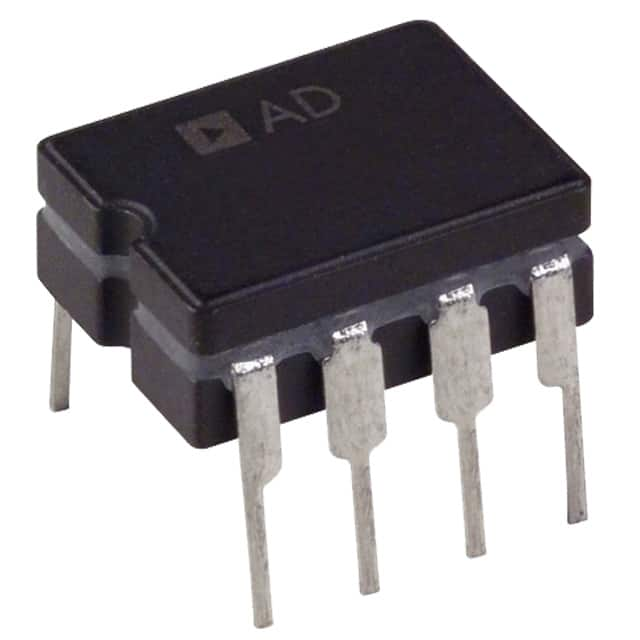OP27AZ/883C
Product Overview
- Category: Operational Amplifier
- Use: Signal amplification and conditioning in various electronic circuits
- Characteristics:
- High precision and low offset voltage
- Low noise and distortion
- Wide bandwidth
- High input impedance
- Stable performance over a wide temperature range
- Package: Ceramic DIP (Dual In-line Package)
- Essence: Precision operational amplifier designed for high-performance applications
- Packaging/Quantity: Available in tubes or trays, quantity varies based on manufacturer
Specifications
- Supply Voltage: ±15V
- Input Offset Voltage: 50µV max
- Input Bias Current: 10nA max
- Input Voltage Noise: 0.6µVrms
- Gain Bandwidth Product: 8MHz min
- Slew Rate: 5V/µs min
- Operating Temperature Range: -55°C to +125°C
Detailed Pin Configuration
The OP27AZ/883C has a standard 8-pin dual in-line package (DIP) configuration with the following pinout:
- Non-Inverting Input (+IN)
- Inverting Input (-IN)
- Negative Power Supply (-V)
- Output (OUT)
- Offset Null
- Positive Power Supply (+V)
- NC (No Connection)
- NC (No Connection)
Functional Features
- High precision amplification of small signals
- Low input offset voltage for accurate signal processing
- Low noise and distortion for improved signal quality
- Wide bandwidth allows for amplification of high-frequency signals
- High input impedance minimizes loading effects on the source
- Stable performance across a wide temperature range ensures reliability
Advantages and Disadvantages
Advantages: - High precision and accuracy - Low noise and distortion - Wide bandwidth for versatile applications - Stable performance over a wide temperature range
Disadvantages: - Relatively higher cost compared to general-purpose operational amplifiers - Limited availability in certain markets
Working Principles
The OP27AZ/883C is based on the principles of operational amplifier circuits. It utilizes differential input stages, feedback mechanisms, and active components to amplify and condition input signals. The internal circuitry is designed to minimize offset voltage, noise, and distortion while providing high gain and stability.
Detailed Application Field Plans
The OP27AZ/883C finds extensive use in various applications, including:
- Precision measurement equipment
- Data acquisition systems
- Medical instrumentation
- Audio signal processing
- Industrial control systems
- Test and measurement instruments
- Communication equipment
Its high precision, low noise, and stable performance make it suitable for applications that require accurate signal amplification and conditioning.
Detailed and Complete Alternative Models
- AD8675: Precision Operational Amplifier with Rail-to-Rail Output
- LT1677: Low Noise, Precision Operational Amplifier
- OPA211: High Precision, Low Noise Operational Amplifier
- MCP601: Low Power, Rail-to-Rail Input/Output Operational Amplifier
- MAX4239: Ultra-Low Offset Voltage, Precision Operational Amplifier
These alternative models offer similar features and performance characteristics to the OP27AZ/883C and can be considered as alternatives based on specific application requirements.
Word count: 409 words
Lista 10 Vanliga frågor och svar relaterade till tillämpningen av OP27AZ/883C i tekniska lösningar
What is the typical supply voltage range for OP27AZ/883C?
- The typical supply voltage range for OP27AZ/883C is ±5V to ±18V.What is the input offset voltage of OP27AZ/883C?
- The input offset voltage of OP27AZ/883C is typically 25μV.Can OP27AZ/883C operate in single-supply applications?
- Yes, OP27AZ/883C can operate in single-supply applications with proper biasing.What is the typical input bias current of OP27AZ/883C?
- The typical input bias current of OP27AZ/883C is 0.6nA.Is OP27AZ/883C suitable for precision instrumentation applications?
- Yes, OP27AZ/883C is suitable for precision instrumentation applications due to its low offset voltage and low noise characteristics.What is the maximum output voltage swing of OP27AZ/883C?
- The maximum output voltage swing of OP27AZ/883C is typically ±13V with a ±15V supply.Does OP27AZ/883C have built-in protection features?
- Yes, OP27AZ/883C has built-in electrostatic discharge (ESD) protection on all pins.What is the temperature range for OP27AZ/883C?
- OP27AZ/883C is designed to operate over a temperature range of -55°C to +125°C.Can OP27AZ/883C be used in active filter designs?
- Yes, OP27AZ/883C can be used in active filter designs due to its low noise and high gain bandwidth product.What is the typical open-loop gain of OP27AZ/883C?
- The typical open-loop gain of OP27AZ/883C is 500,000.


